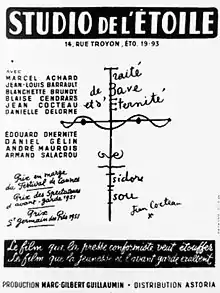Venom and Eternity
Venom and Eternity (French: Traité de Bave et d'Éternité, lit. 'Treatise on Slobber and Eternity') is a 1951 French avant-garde film by Isidore Isou that grew out of the Lettrist movement in Paris.[1] It created a scandal at the 1951 Cannes Film Festival.[2]
| Venom and Eternity | |
|---|---|
 | |
| Directed by | Isidore Isou |
| Written by | Isidore Isou |
| Produced by | Marc-Gilbert Guillaumin |
| Starring |
|
| Narrated by | Bernard Blin |
| Cinematography | Nat Saufer |
| Edited by | Suzanne Cabon |
Release date |
|
Running time | 120 minutes |
| Country | France |
| Language | French |
Description
Venom and Eternity is arranged in a three-part structure. The first chapter, "Principle" (French: "Le principe"), displays people walking around the streets of Paris as the audio track presents an argument at a film society. The second chapter, "Development" (French: "Le développement"), shows a romantic meeting between two people. This section is combined with found footage. The final chapter, "Proof" (French: "La preuve"), uses increasingly abstract images, including countdown leader and clear leader. Its audio track resumes the debate from "Principle" and features Lettrist poetry.[3]
Production
Isou began filming Venom and Eternity in 1950.[4] The scenes of various Lettrists walking were shot on the streets of Saint-Germain-des-Prés.[3] Isou used found footage discarded by the Ministry of Defence and various film laboratories.[4]
Release
Isou first screened a four-and-a-half-hour rough cut of the film on 20 April 1951.[5][6] Fearing that he would be deported from France in the event of public controversy, Isou had the film transported to the 1951 Cannes Film Festival by Marc'O, Jean-Louis Brau, François Dufrene, Maurice Lemaître, and Gil J. Wolman. Isou was unable to enter Venom and Eternity into the festival but harassed officials until they allowed him to present his film at the Vox Theater.[7][8]
At the time of the premiere, only the first third of the film had a completed image track.[9] A hostile audience began jeering shortly after the film began. After the first section finished, the screen went blank. The projector light was turned off as the audio track continued to play to a darkened theatre. Audience members were infuriated, and the screening was ended early.[8][10] Accounts of the scandalous response described a rioting audience and police officers using fire hoses on the crowd, but these stories are largely apocryphal. Director Jean Cocteau awarded Isou the "Prix de spectateurs d'avant-garde" for Venom and Eternity.[8][11]
As soon as Venom and Eternity was completed, the Ciné-Club Avant-Garde 52 showed it at the Musée de l'Homme in Paris.[12] Starting in January 1952, it had a two-week theatrical run at the Studio de l'Etoile.[13]
Legacy
Venom and Eternity was the first cinematic work by the Lettrist movement.[14] The film became a major influence on the work of Stan Brakhage.[15]
Notes
- Andrew Hussey, The Strange and Enchanted Life of Isidore Isou, Reaktion Books, pp. 201-204
- Book Review of The Strange and Enchanted Life of Isidore Isou at Whitehot Magazine of Contemporary Art
- Cabañas 2014, pp. 31.
- Wall-Romana 2012, p. 229.
- Cabañas 2014, p. 1.
- Bergan, Ronald (20 August 2007). "Is cinema dead?". The Guardian.
- Cabañas 2014, pp. 22–23.
- Uroskie, Andrew V. (2011). "Beyond the Black Box: The Lettrist Cinema of Disjunction". October. 135: 23–26. doi:10.1162/octo_a_00019. S2CID 57565300.
- Cabañas 2014, p. 25.
- Wall-Romana 2012, p. 230.
- Verrone 2011, p. 65.
- Andrew Hussey, The Strange and Enchanted Life of Isidore Isou, Reaktion Books, p. 203
- Cabañas 2014, pp. 33–34.
- "Traité de bave et d'eternité / On Venom and Eternity (DVD)". shop.bfi.org.uk. Retrieved 2023-06-10.
- Cabañas 2014, pp. 136–137.
References
- Cabañas, Kaira M. (2014). Off-Screen Cinema: Isidore Isou and the Lettrist Avant-Garde. University of Chicago Press. ISBN 978-0-226-17459-4.
- Verrone, William E.B. (2011). The Avant-Garde Feature Film: A Critical History. McFarland & Company. ISBN 978-0-7864-5910-0.
- Wall-Romana, Christophe (2012). Cinepoetry: Imaginary Cinemas in French Poetry. Fordham University Press. ISBN 978-0-8232-4548-2.